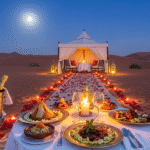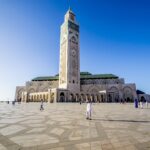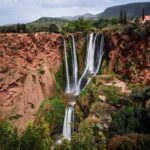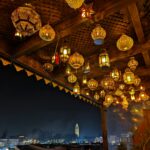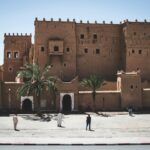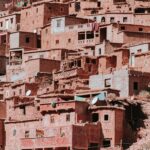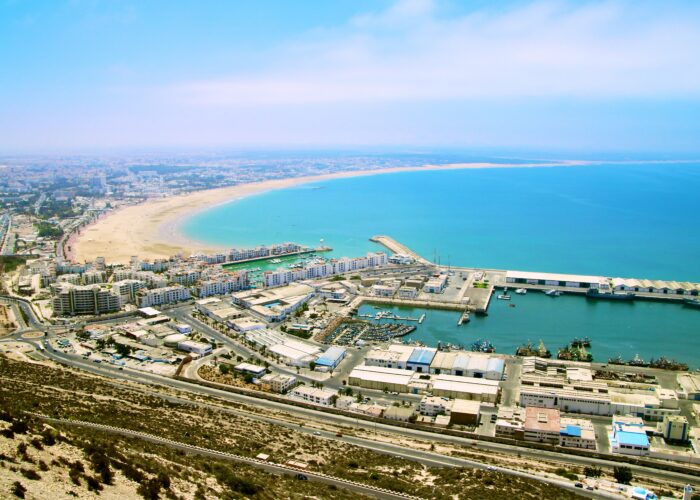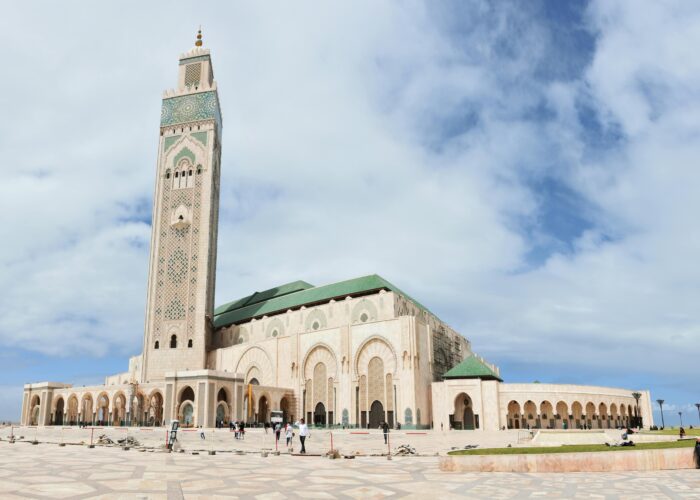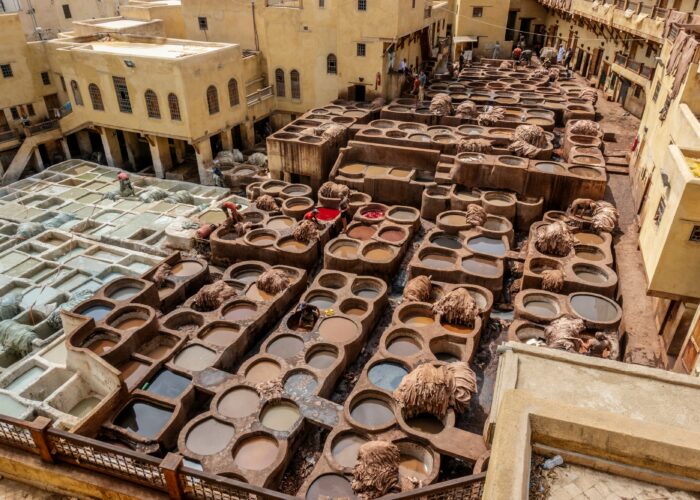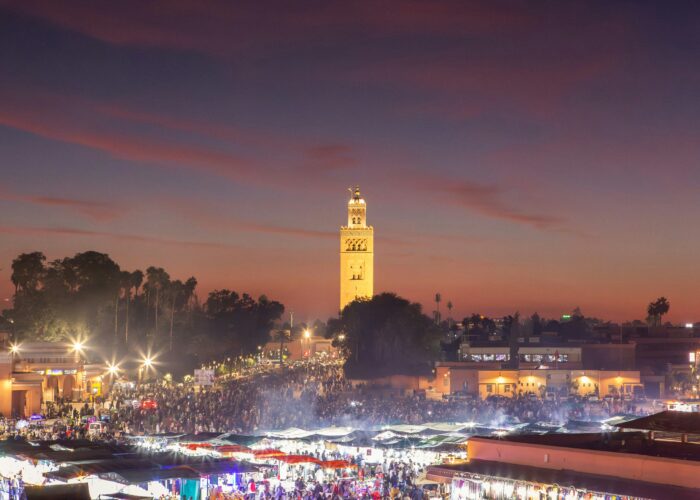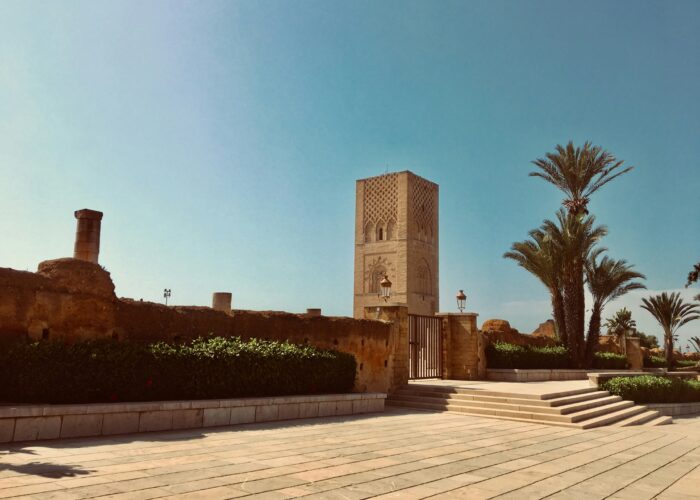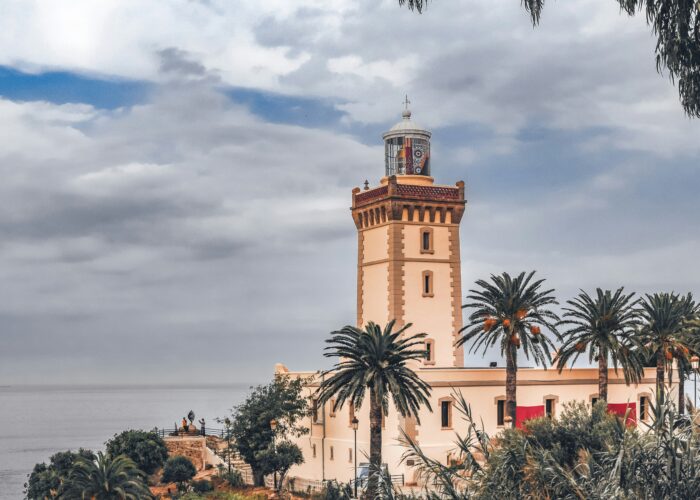Rich Cultural Heritage
Morocco is a captivating country that offers a rich cultural heritage, reflecting a unique fusion of Arab, Berber, and European influences. This diversity is evident in the country’s historical landmarks, ancient traditions, and vibrant arts and crafts. Travelers seeking a deep understanding of different cultures will find Morocco’s heritage particularly enriching.
The historical landmarks of Morocco serve as a testament to its storied past. Cities such as Marrakech, Fes, and Rabat are home to stunning architecture that embodies the intricacies of Moroccan design. The Koutoubia Mosque in Marrakech, for instance, is an iconic example of the Almohad architectural style, while the ancient medina of Fes is recognized as a UNESCO World Heritage Site, exemplifying medieval Moroccan urbanism. Such sites not only exhibit aesthetic beauty, but also tell the stories of the people who once inhabited these regions.
In addition to its architectural wonders, Morocco is profoundly rich in traditions. Festivals such as the Fes Festival of World Sacred Music showcase the country’s diverse musical heritage, bringing together artists from various backgrounds. Additionally, local customs and practices, from the art of henna application to the intricate techniques of Moroccan storytelling, highlight the significance of cultural preservation. This cultural immersion allows travelers to experience firsthand the living heritage of Morocco.
The vibrancy of Moroccan arts and crafts adds yet another layer to its cultural richness. Renowned for their intricate textiles, ceramics, and metalwork, Moroccan artisans uphold age-old techniques and skills that have been passed down through generations. Markets and souks are full of handmade products that reflect the creativity and diversity of the Moroccan people, offering visitors not only souvenirs but also pieces of the country’s soul.
Stunning Landscapes
Morocco is a land of extraordinary diversity, offering a rich tapestry of landscapes that cater to a wide array of adventurer’s desires. From the towering peaks of the Atlas Mountains to the sweeping dunes of the Sahara Desert, each region presents its own unique allure. The Atlas Mountains serve as a magnificent spine through the country, adorned with lush valleys, terraced hillsides, and traditional Berber villages, providing ample opportunities for hiking, trekking, and immersing oneself in the local culture.
In contrast to the rugged mountains, the coastal areas of Morocco provide a serene escape. The Atlantic coastline is lined with charming towns such as Essaouira and Agadir, where travelers can enjoy pristine beaches, water sports, and views that seem to stretch into eternity. The azure waters and vibrant marine life create a haven for those interested in relaxation or adventure alike.
Moving inward, the Sahara Desert reveals one of nature’s most mesmerizing spectacles. Its vast, sun-kissed sands lie in stark contrast to the strikingly clear blue sky. Exploring this iconic desert can be done through guided camel treks or 4×4 excursions that allow visitors to witness breathtaking sunsets and experience the tranquility of the dunes. In this remote setting, one can engage with nomadic tribes, learning about their way of life and the resilience required to survive in such an environment.
For those keen on photography, the varied landscapes of Morocco present extraordinary opportunities to capture stunning imagery, whether it’s the colors of a sunset behind the dunes, the mountain flora in bloom, or the coastal sunsets over the Atlantic. Each landscape tells a story, inviting travelers to create their own memories against such a dramatic backdrop.
Delicious Cuisine
Moroccan cuisine is celebrated around the globe for its rich flavors, vibrant colors, and diverse ingredients that reflect the country’s history and cultural influences. Renowned for its unique blends of spices, such as cumin, coriander, saffron, and cinnamon, Moroccan dishes are a feast for the senses. One of the most iconic staples of this culinary landscape is tagine, a slow-cooked stew roasted in a clay pot, typically filled with a variety of meats, vegetables, and aromatic spices. Each region in Morocco has its unique twist on tagine, providing culinary enthusiasts with a multitude of flavors to explore.
Another quintessential dish that should not be missed is couscous, often regarded as the national dish of Morocco. Traditionally served on Fridays, this fluffy grain is usually accompanied by a hearty stew or lightly spiced vegetables. The preparation of couscous is an art form, often involving multiple steps to achieve the perfect texture, making the experience of enjoying it even more special.
In addition to these staple dishes, Morocco boasts a vibrant street food scene that offers a delightful opportunity for travelers to immerse themselves in local culture. From savory pastries like pastilla to the aromatic scent of grilled meat skewers, the bustling markets and food stalls present a plethora of options. Sampling these culinary delights allows visitors to engage directly with locals, fostering a deeper appreciation for the nation’s gastronomy.
Food holds a significant place in Moroccan society, often serving as a medium for social interactions and celebrations. Gatherings centered on meals provide a unique glimpse into the hospitality and warmth that define Moroccan culture, making gastronomy not just a necessity but a way of connecting with others. For food lovers eager to explore new flavors and experiences, Morocco’s captivating cuisine undoubtedly makes it a must-visit travel destination.
Vibrant Souks and Markets
The heart of Moroccan culture is often found in its vibrant souks, where the rhythmic pulse of daily life can be felt through a sensory overload of colors, scents, and sounds. Each souk is a maze of winding alleyways and stalls that offer a wide array of goods—from intricate handicrafts to traditional textiles and exotic spices. Shopping in these markets is not merely a transaction; it is an immersive cultural experience that highlights local craftsmanship and the rich heritage of Morocco.
As you stroll through the bustling markets, you will encounter artisans showcasing their handmade products, such as beautiful Berber rugs, ornate lamps, and handcrafted pottery. The textiles available are particularly noteworthy, featuring bright colors and intricate patterns that are symbolic of Moroccan identity. Additionally, the aroma of spices envelops visitors, with stands overflowing with saffron, cumin, and more, promising to transform ordinary dishes into culinary delights.
However, shopping in these souks is not without its challenges. Navigating through the crowded lanes requires some awareness—both of your surroundings and the art of haggling. Bargaining is customary in Moroccan markets and is often considered a friendly engagement rather than an uncomfortable confrontation. It is advisable to begin by offering a price lower than the one quoted and to expect a counteroffer. This dance is an integral part of the experience, as it not only secures a better deal but also allows for interaction with local vendors who are typically warm and welcoming.
It is worth noting that while the vibrant souks provide endless opportunities for finding unique treasures, it is essential to remain mindful of personal belongings and never lose sight of your surroundings. Embrace the lively atmosphere, engage with the locals, and relish the exhilarating journey that the Moroccan souks offer. Whether you are seeking a souvenir or simply exploring, these markets are a quintessential part of your Moroccan adventure.
Warm Hospitality
The warm hospitality of Morocco is a cornerstone of its cultural fabric, eagerly embraced by visitors from around the globe. Renowned for their welcoming nature, the Moroccan people take great pride in making strangers feel at home. This warm hospitality is more than just a cultural norm; it is a tradition steeped in the values of kindness and generosity, reflecting the country’s rich heritage.
Travelers often recount their experiences of being greeted with friendly smiles and open arms. Many visitors find themselves invited into homes where they are treated to authentic Moroccan meals and tea, known as “Atay,” which is a significant part of local traditions. This custom of sharing food and drink showcases the locals’ commitment to fostering connections and friendships, transforming a simple visit into an enriching experience.
Interactions with local people can significantly enhance the travel experience by providing insights into Moroccan customs and practices. Whether it is a small village or a bustling city, the warmth exhibited by shopkeepers, artisans, and hospitality staff creates an inviting atmosphere for tourists. For instance, a traveler may find themselves engaging in a lively conversation with a craftsman while observing his artistry or enjoying storytelling sessions with local families, which weave history into the present moment.
Such genuine engagements allow travelers to immerse themselves deeply in the culture, leading to a greater appreciation of the country’s traditions and values. The warmth of Moroccan hospitality not only enriches one’s travel experience but also emphasizes the broader interconnectedness of human experiences, encouraging a sense of belonging that transcends borders.
Historical Cities and Architecture
Morocco is a country rich in history and culture, vividly reflected in its historical cities and stunning architecture. The cities of Marrakech, Fes, and Chefchaouen stand out as prime examples of this extraordinary heritage, showcasing an array of intricate designs that illustrate the nation’s past and cultural diversity. Each city offers its own unique architectural style, inviting travelers to explore the depths of Moroccan history.
Marrakech, the vibrant jewel of Morocco, is known for its bustling souks and stunning palaces. The Koutoubia Mosque, an iconic symbol of the city, features an exquisite minaret that dates back to the 12th century. Visitors to Marrakech can immerse themselves in the remarkable intricacies of the Bahia Palace and the Saadian Tombs, which display the beautiful artistry of Moorish architecture and the region’s historical significance. The Medina of Marrakech, a UNESCO World Heritage site, is a labyrinth of alleys filled with colorful markets, age-old riads, and exquisite fountains, perfect for a deep dive into both history and local culture.
Fes, the cultural capital of Morocco, boasts the world’s oldest university, Al Quaraouiyine, established in 859 AD. Its medieval medina, Fes el-Bali, is renowned for its well-preserved architecture and is a remarkable example of Islamic urban design. The intricate tile work, ornate wood carvings, and grand historical buildings allow visitors to traverse back in time, experiencing the grandeur of the past firsthand. Each corner of the city reveals an exquisite detail, reflecting the skill and craftsmanship of Moroccan artisans throughout the centuries.
Chefchaouen, often referred to as the “Blue City,” offers a distinct charm with its blue-painted buildings and stunning mountain backdrop. The city features Moroccan and Andalusian architectural influences that create a serene, picturesque atmosphere. Exploring its narrow, cobbled streets, visitors can appreciate the unique blend of cultures that have shaped its identity. Overall, the historical cities of Morocco serve as a window into the rich tapestry of the nation’s architecture, offering travelers a profound understanding of its cultural heritage.
Adventure Activities
For those with an adventurous spirit, Morocco serves as an exceptional playground filled with exhilarating activities that can satisfy any thrill-seeker. The diverse landscapes, from the vast Sahara Desert to the rugged Atlas Mountains, provide ample opportunities for outdoor enthusiasts to explore. One of the most popular adventure activities in Morocco is hiking, particularly in the High Atlas region, where trails like those in Imlil lead to stunning vistas of soaring peaks and picturesque valleys. Travelers can experience the local Berber culture while trekking through traditional villages, allowing both adventure and cultural immersion to coexist.
Camel trekking is another iconic experience that visitors should not miss. Navigating through the majestic Sahara Desert on the back of a camel offers a unique perspective of its sweeping sand dunes and vast horizons. The adventure typically culminates in a night under the starry desert sky, enhancing the overall experience with both comfort and allure. Tour operators commonly provide guided excursions, enabling both novices and seasoned adventurers to partake in this captivating journey.
For those who prefer a splash of adrenaline, Morocco’s coastline offers fantastic surfing opportunities, particularly in Agadir and Taghazout. These spots are acclaimed for their consistent waves and stunning seascapes, attracting surfers from around the globe. Surf schools in these areas cater to all skill levels, making it accessible for beginners looking to ride their first wave or for seasoned surfers in pursuit of the ideal swell.
Overall, the adventure activities available in Morocco create an irresistible allure for outdoor enthusiasts. Whether it’s hiking through mountainous terrain, camel riding across desert landscapes, or surfing along the Atlantic Coast, Morocco undoubtedly offers a wide array of thrilling experiences that invite travelers to embrace their adventurous side.
Unique Festivals and Events
Morocco is renowned for its rich and diverse culture, which is beautifully showcased through its vibrant festivals and events that take place throughout the year. These celebrations reflect the nation’s historical heritage, artistic expressions, and regional traditions, making them an integral part of Moroccan life. Travelers are encouraged to align their visits with these festivities to experience the nation’s spirit fully.
One of the most significant events is the Fes Festival of World Sacred Music, typically held in June. This remarkable festival attracts artists and performers from around the globe, offering an array of performances in stunning historical venues within the city of Fes. The event emphasizes not just music but also the dialogue between cultures, creating a unique atmosphere of spiritual harmony and unity.
Another noteworthy festival is the Marrakech Popular Arts Festival, which usually occurs in July. This week-long celebration showcases traditional Moroccan music, dance, and arts, bringing together both locals and tourists. Visitors can immerse themselves in the performances that feature everything from folkloric dances to artistic displays, providing a deeper appreciation of Moroccan culture.
The Rose Festival in the Dades Valley, typically celebrated in May, is a feast for the senses, featuring activities centered around the blooming of the local rose. This event offers stunning floral displays, local crafts, and culinary delights, inviting guests to partake in the enchanting ambiance of the valley. It provides an authentic experience of Moroccan rural life and the importance of agriculture in the region.
These festivals are just a glimpse of the vibrant cultural landscape that Morocco has to offer. By planning a trip around these events, travelers not only enjoy the stunning sights and sounds of Morocco but also gain insights into the country’s traditions and societal values. Participating in these festivals fosters connections with local communities, enhancing the overall travel experience in this enigmatic nation.
Affordable Travel Options
Morocco is renowned for its budget-friendly travel opportunities, making it an attractive destination for a range of travelers, including backpackers and families alike. One of the most appealing aspects of traveling in Morocco is the variety of cost-effective transportation methods available. For those looking to explore the vibrant cities or stunning landscapes, buses serve as an affordable and convenient means of travel. The national bus service, CTM, offers comfortable and reliable rides between major cities, while local buses provide an extensive network for urban travel at very low costs.
In addition to bus travel, the use of grand taxis—shared vehicles that operate between defined routes—offers an economical way to navigate rural areas and smaller towns. This allows travelers to cut down on costs while still enjoying the experience of meeting locals and engaging with the culture. For those seeking to explore more remote locations, rideshare services have gained popularity in Morocco, providing an affordable option without the expense of a private vehicle.
When it comes to accommodation, Morocco is home to a wide range of options to suit every budget. From luxurious hotels to budget hostels and charming guesthouses, known as riads, visitors can find lodgings that won’t strain their finances. Many riads offer comfortable rooms at reasonable prices, and some even include meals, providing travelers with an opportunity to immerse themselves in Moroccan hospitality without overspending.
Beyond transportation and lodging, experiencing local culture through affordable activities is part of what makes Morocco accessible. Many markets, historical sites, and public festivals are free or charge a nominal entry fee, allowing travelers to enjoy rich cultural experiences without financial burden. In summary, with its numerous low-cost travel options, Morocco stands out as a destination where travelers can enjoy memorable experiences without breaking the bank.




